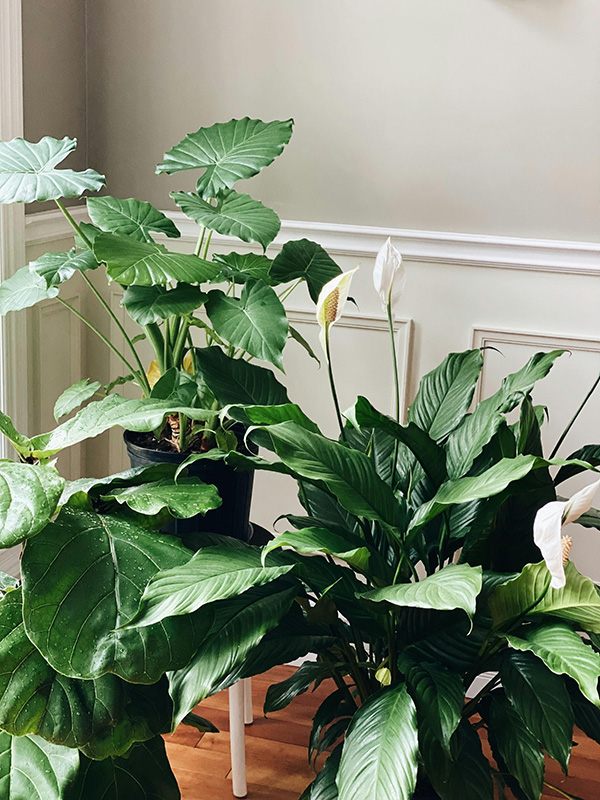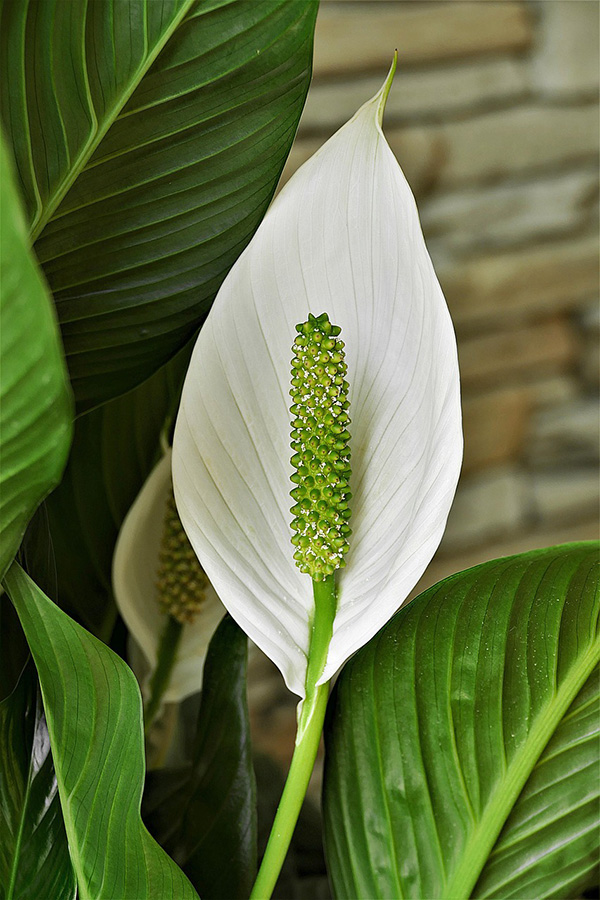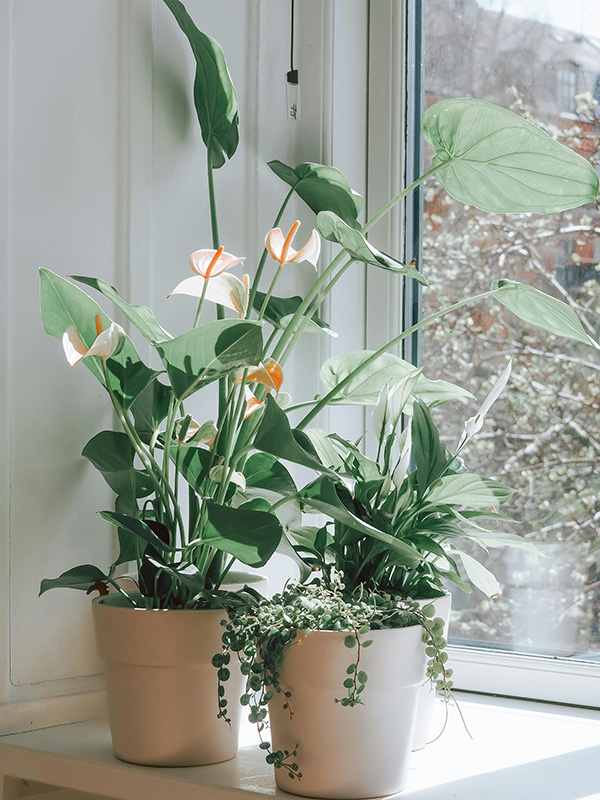Amid the fast-paced cadence of contemporary living, discovering moments of tranquility can be a precious and invaluable gift. Amid the concrete and chaos, there exists a serene companion that brings a touch of nature's peace into our homes – the Peace Lily. Adorned with elegant white blooms and lush green leaves, the Peace Lily symbolizes serenity and renewal.
In this comprehensive guide, we will share Peace Lily care, equipping you with the knowledge and techniques needed to nurture this symbol of peace and prosperity.. From light and water requirements to troubleshooting common issues, our mission is to equip you with the knowledge to ensure your Peace Lily thrives, embodying peace and vitality in your home.
Botanical Name
Common Name
Plant Type
Mature Size
Sun Requirement
Soil Type
Hardiness Zone
Pet Friendly
Spathiphyllum spp.
Peace Lily
Perennial, Houseplant
1 to 4 feet in height and width
Shade to Partial Sun
Rich, Well-Drained, Loamy
11 to 12 USDA (primarily grown indoors elsewhere)
Mildly toxic to cats and dogs if ingested
What Are Peace Lilies
Peace Lilies, scientifically identified as Spathiphyllum, are well-known for their graceful appearance and air-purifying characteristics. Hailing from the rainforests of Central and South America, these perennial evergreens are classified within the Araceae family. Their name, "Peace Lily," stems from the elegant white flowers resembling a white flag of peace, borne on long, slender stems.
Peace Lilies are distinguished by their glossy, dark green leaves, which elegantly arch and create an appealing backdrop to the exquisite white spathes. These spathes enclose the actual flowers, adding to their allure. With their striking appearance and ability to thrive in low-light conditions, Peace Lilies have become a symbol of tranquility and are a popular choice for indoor plant enthusiasts worldwide.
Common Varieties of Peace Lilies
Peace Lilies (Spathiphyllum) are a diverse group of plants, and while they don't have as many cultivars as some other houseplants, there are a few common varieties that are worth noting:
Spathiphyllum wallisii: This is the classic Peace Lily variety with dark green leaves and white spathes. This variety is the most extensively cultivated and is recognized for its air-purifying capabilities.
Spathiphyllum 'Mauna Loa': This variety is a larger version of the standard Peace Lily, producing larger leaves and taller white spathes. It is frequently selected for its impressive size and refined appearance.
Spathiphyllum 'Sensation': The Sensation variety stands out due to its dramatic, larger leaves with white veining. It's a visually striking Peace Lily that adds a unique touch to any indoor space.
Spathiphyllum 'Domino': Domino Peace Lilies feature dark green leaves with white variegation, resembling a speckled or "domino" pattern. This variety adds a decorative flair to your plant collection.
Spathiphyllum 'Clevelandii': Known for its compact size, the Clevelandii variety is a perfect choice for smaller spaces. It maintains the classic Peace Lily appearance with smaller dimensions.
Spathiphyllum 'Power Petite': As the name suggests, Power Petite is a miniature Peace Lily variety, making it ideal for tiny pots or terrariums. Despite its size, it retains the signature white spathes and green foliage.

Peace Lily Plant Care Requirements
Light
Peace lilies are renowned for their adaptability to diverse light conditions, contributing to their popularity as indoor plants. When growing peace lily indoors, they thrive in bright light conditions but can tolerate moderate to low-light environments. They do not necessitate direct sunlight and, in fact, can be adversely affected by excessive exposure. Optimal locations include areas with filtered or indirect sunlight near a north or east-facing window. Their glossy green leaves and graceful white spathes can withstand lower light levels, rendering them suitable for offices or rooms with limited natural light.
Water
Peace Lilies have specific water requirements that are essential for their well-being. These plants thrive when their soil is consistently moist but not waterlogged. To sustain the optimal moisture level, thoroughly water the plant when the top inch of the soil feels dry. Ensure excess water drains from the pot, as stagnant water can result in root rot.
Peace Lilies are excellent at signaling their hydration needs through drooping leaves, making it easy to tell when they require water. Proper watering is key to keeping these elegant plants healthy, and it helps prevent common issues like yellowing leaves.
Temperature
Most peace lilies are flexible when it comes to temperature requirements, making them adaptable for indoor cultivation. Peace lilies flourish in standard indoor temperatures, ideally between 65 to 80 degrees Fahrenheit (18-27 degrees Celsius). These plants are sensitive to cold drafts, so it's crucial to refrain from situating them near air conditioning vents or open windows during chilly weather. While they can tolerate slightly cooler nighttime temperatures, shielding them from drastic temperature fluctuations is advisable.
Humidity
Peace Lilies, known for their lush green foliage and elegant white spathes, appreciate moderate to high humidity levels when grown indoors. Humidity is pivotal for maintaining their overall health and appearance.
In their natural rainforest habitat, Peace Lilies thrive in humid conditions. To replicate this environment indoors, you may want to use a humidity tray filled with water and pebbles beneath the plant. As the water evaporates, it enhances the moisture around the plant. Another option is a room humidifier, which can effectively maintain optimal humidity levels, particularly in dry indoor environments.
During the drier winter months or in regions with low humidity, providing extra moisture is essential. Placing your Peace Lily in rooms like bathrooms or kitchens, where humidity tends to be higher due to daily activities like showers or cooking, can also be beneficial.
Inadequate humidity levels can result in problems such as brown leaf tips and diminished flowering. Therefore, ensuring that the humidity level remains above 40% is advisable for the overall well-being of your Peace Lily when it's growing indoors.
Soil
Peace Lilies grow best in well-draining, organic potting mixtures. A typical mix consists of peat moss, perlite, and pine bark, which provides the necessary balance of moisture retention and drainage. This composition prevents waterlogged roots, a common issue that can harm Peace Lilies. Additionally, the slightly acidic to neutral pH of the soil is ideal. Avoid using heavy garden soils or those prone to compaction, as they hinder proper root aeration. Choose an appropriate potting mix to promote the health of your Peace Lily.

Fertilization
Fertilizing Peace Lilies when grown indoors is a straightforward yet vital aspect of their care. These low-maintenance plants thrive with regular feeding during the growing season, typically spring through summer.
An appropriate choice for fertilizing is a balanced, water-soluble fertilizer with equal parts of nitrogen, phosphorus, and potassium. Dilute the fertilizer to half the recommended strength and apply it every 6-8 weeks.
Be cautious of over-fertilizing, as it can result in salt buildup in the soil, potentially causing damage to the roots. Reduce or cease fertilization during the dormant winter period. Properly timed and balanced fertilization ensures healthy foliage and occasional white spathes, enhancing the overall beauty of your Peace Lily.
Propagation
Propagation of Peace Lilies indoors primarily involves division, and it's a straightforward process that allows you to create new plants from a mature one. Here's how to do it:
- Select a well-established Peace Lily that has either outgrown its current container or requires rejuvenation.
- Gently extract the plant from its pot, carefully shaking off any excess soil. You'll notice that the plant has multiple stems or clumps of stems emerging from the root ball.
- Inspect the root ball and identify natural divisions or sections with their own stems and roots. These can be gently separated by pulling them apart or using clean, sharp scissors or pruning shears. Ensure that each division has both healthy roots and leaves.
- Plant each division in a separate container with fresh, well-draining potting mix. Create a hole in the soil and position the divided section in it, covering the roots and compacting the soil around it.
- Following repotting, thoroughly water the divided sections to settle the soil and stimulate root growth.
- The newly propagated Peace Lilies require the same care as mature ones. Place them in an appropriate location with indirect light, maintain proper watering, and ensure suitable humidity levels.
Pruning
Peace Lily plants typically require little pruning. However, occasional maintenance can help maintain their appearance and overall health. Remove any yellowing or brown peace lily leaves, as well as spent flowers, using clean and sharp scissors or pruning shears.
Pruning away these undesirable elements not only enhances the plant's aesthetics but also stimulates new growth. Peace Lilies are resilient and forgiving, making them easy to prune, suitable for both beginners and experienced indoor gardeners. Pruning is a straightforward task that enhances the plant's vitality and beauty.
Pot And Repot
Potting and repotting Peace Lilies (Spathiphyllum) when grown indoors are crucial aspects of their care. Begin by choosing a container with ample space for the plant's roots to grow comfortably. Since these plants prefer being slightly root-bound, opt for a pot that is approximately one to two inches larger in diameter than the current one. Utilize a well-draining potting mix enriched with organic material.
Repotting is recommended every two to three years or when the plant has surpassed the capacity of its current container. Indications that it's time to repot include roots encircling the pot's surface or emerging from the drainage holes. During repotting, delicately extract the plant, trim any damaged roots, and transfer it to a new container with fresh potting mix. Repotting ensures the plant continues to thrive indoors.

Common Problems And Troubleshoots
Yellowing Leaves
Yellowing leaves are a common issue and can be caused by overwatering or underwatering. Excessive watering can result in root rot, whereas insufficient watering causes the plant to dry out. To troubleshoot, ensure the soil is consistently moist but not waterlogged. Provide water to the plant when the top inch of the soil feels dry to the touch.
Brown Leaf Tips
Brown leaf tips are frequently a result of low humidity levels. Peace Lilies thrive in humid conditions, and in dry indoor environments, the leaf tips can turn brown. Enhance humidity around the plant by misting it regularly, positioning a tray of water and pebbles nearby, or employing a room humidifier. Trimming the brown tips can enhance the plant's appearance.
Drooping
If a Peace Lily is drooping, it typically indicates that it requires water. These plants are good at signaling their hydration needs. When you observe drooping, water the plant thoroughly, and it should recover within a few hours.
No Flowers
Lack of flowering can be attributed to insufficient light. Peace Lilies require bright, indirect light to produce their characteristic white spathes. If your plant is not flowering, relocate it to an area with more indirect sunlight. Also, verify that it is not exposed to direct sunlight, which can result in scorched leaves.
Pests
Peace Lilies are susceptible to common indoor pests such as aphids, mealybugs, and spider mites. If you detect these pests, employ a neem oil or insecticidal soap solution to treat the affected areas. Isolate the plant to prevent the infestation from spreading to other indoor plants.
Root Rot
The main cause of root rot in Peace Lilies is typically overwatering. If you suspect root rot, carefully remove the plant from its pot and examine the roots. Healthy roots should appear white while rotting roots are brown and mushy. Trim away any affected roots and repot the plant in fresh soil in a well-draining container.
Brown Spots on Leaves
Brown spots on the leaves may signal fungal or bacterial issues. To address this, promptly remove affected leaves to prevent the spread of the problem. Enhance air circulation around the plant by ensuring it is not crowded with other indoor plants.
Wilting
Wilting may occur if the Peace Lily is exposed to cold drafts or extreme temperature fluctuations. Ensure the plant is positioned away from drafty windows and doors. Maintain a consistent room temperature, ideally between 65-80°F (18-27°C).
Is Peace Lily Pet Friendly
Peace Lilies are a favored indoor plant celebrated for their graceful appearance and air-purifying attributes. Nonetheless, when it involves pets, caution is advised. It's important to note that Peace Lilies are mildly toxic to cats and dogs if ingested. The plant contains compounds called calcium oxalate crystals, which can cause oral irritation, drooling, and digestive discomfort in pets. To keep your furry friends safe, it's best to place Peace Lilies out of their reach or opt for non-toxic houseplants if you have curious pets. While Peace Lilies offers many benefits to your indoor environment, pet safety should always be a priority.

